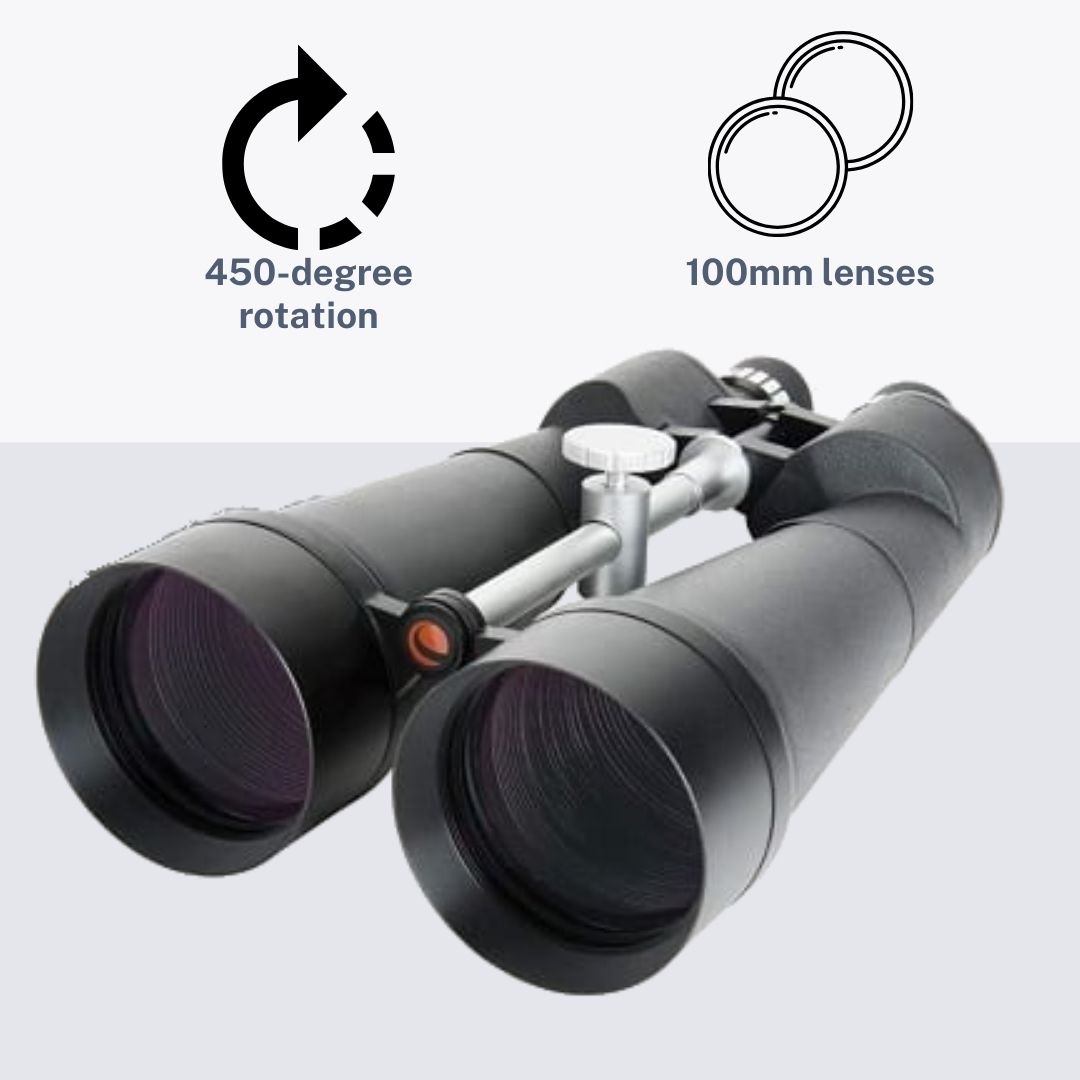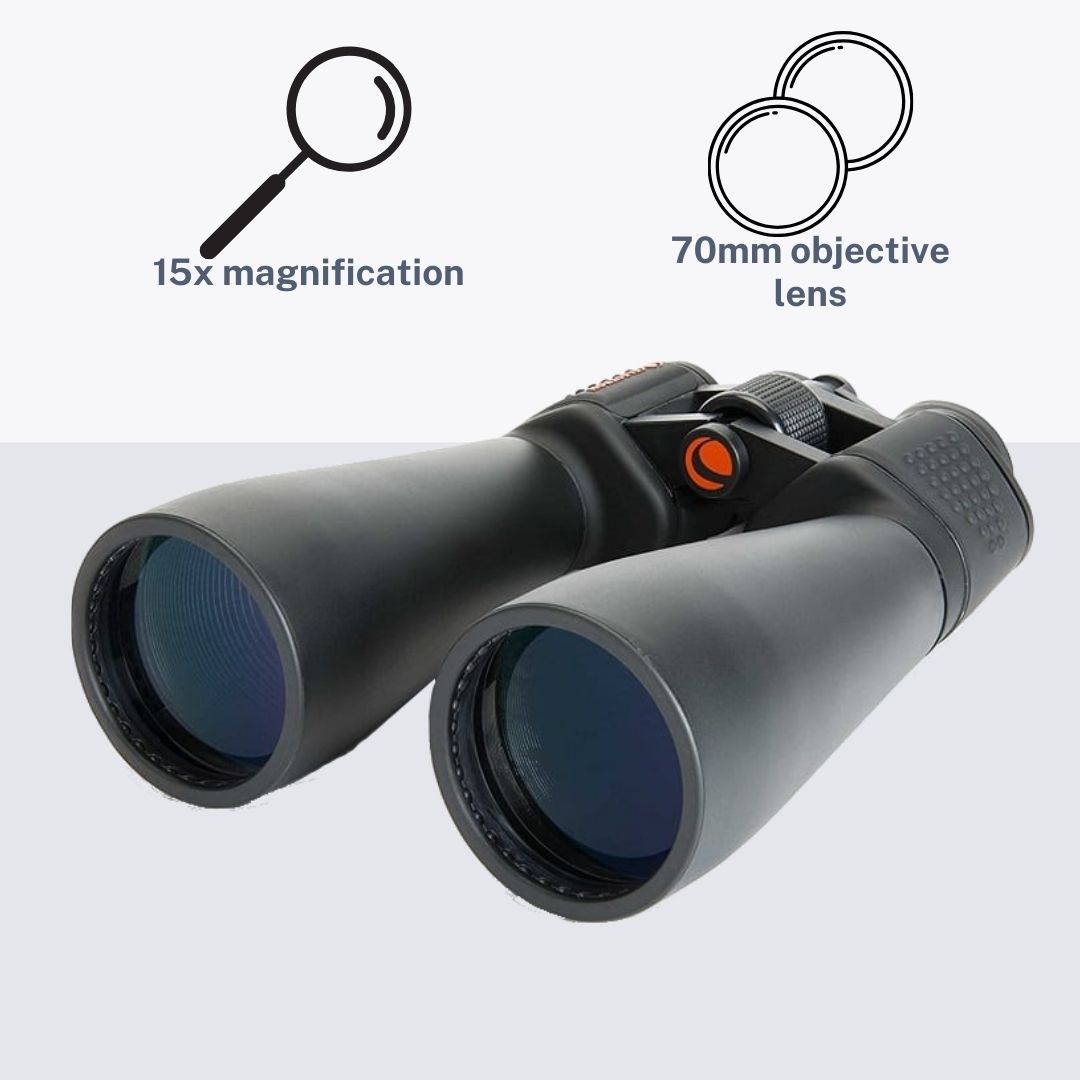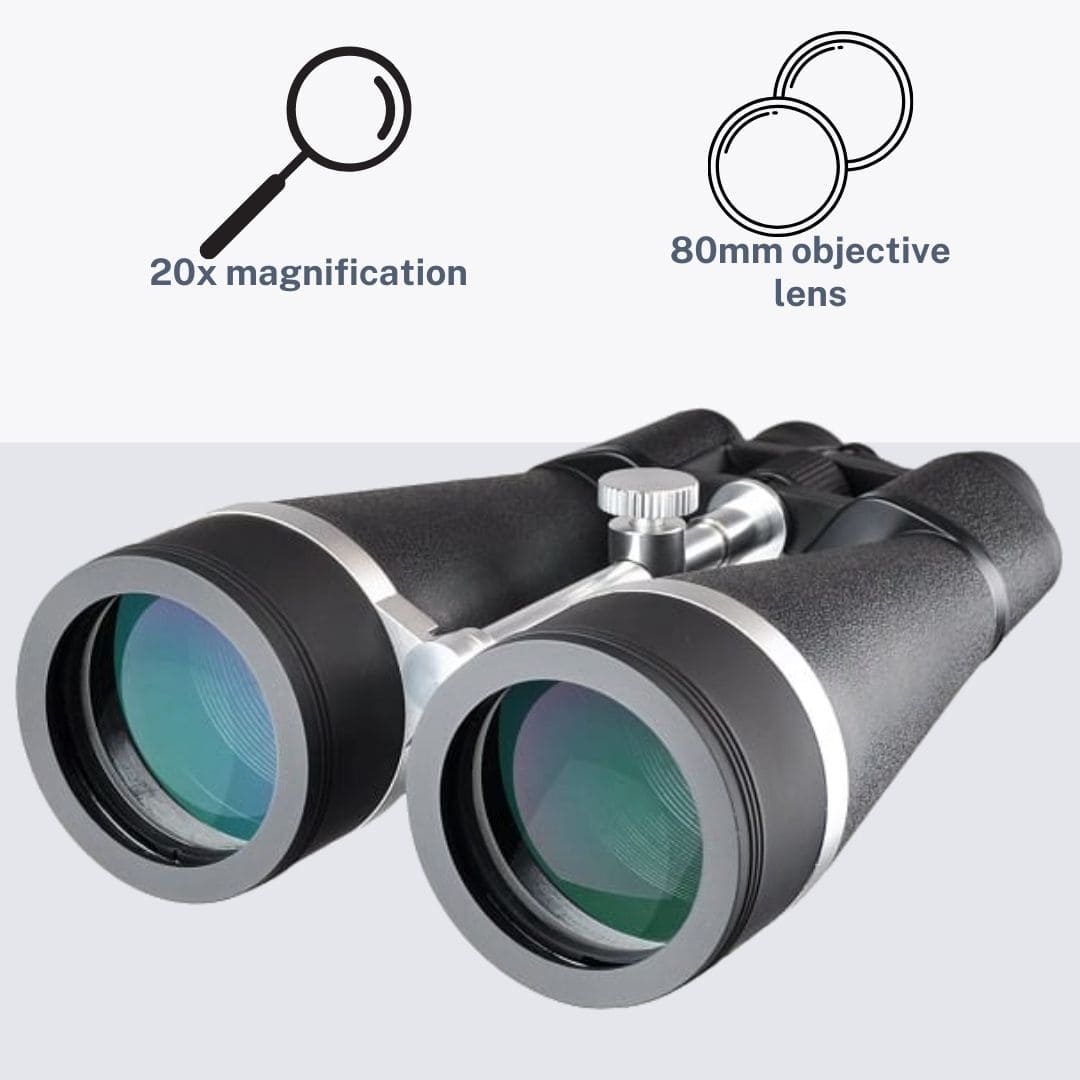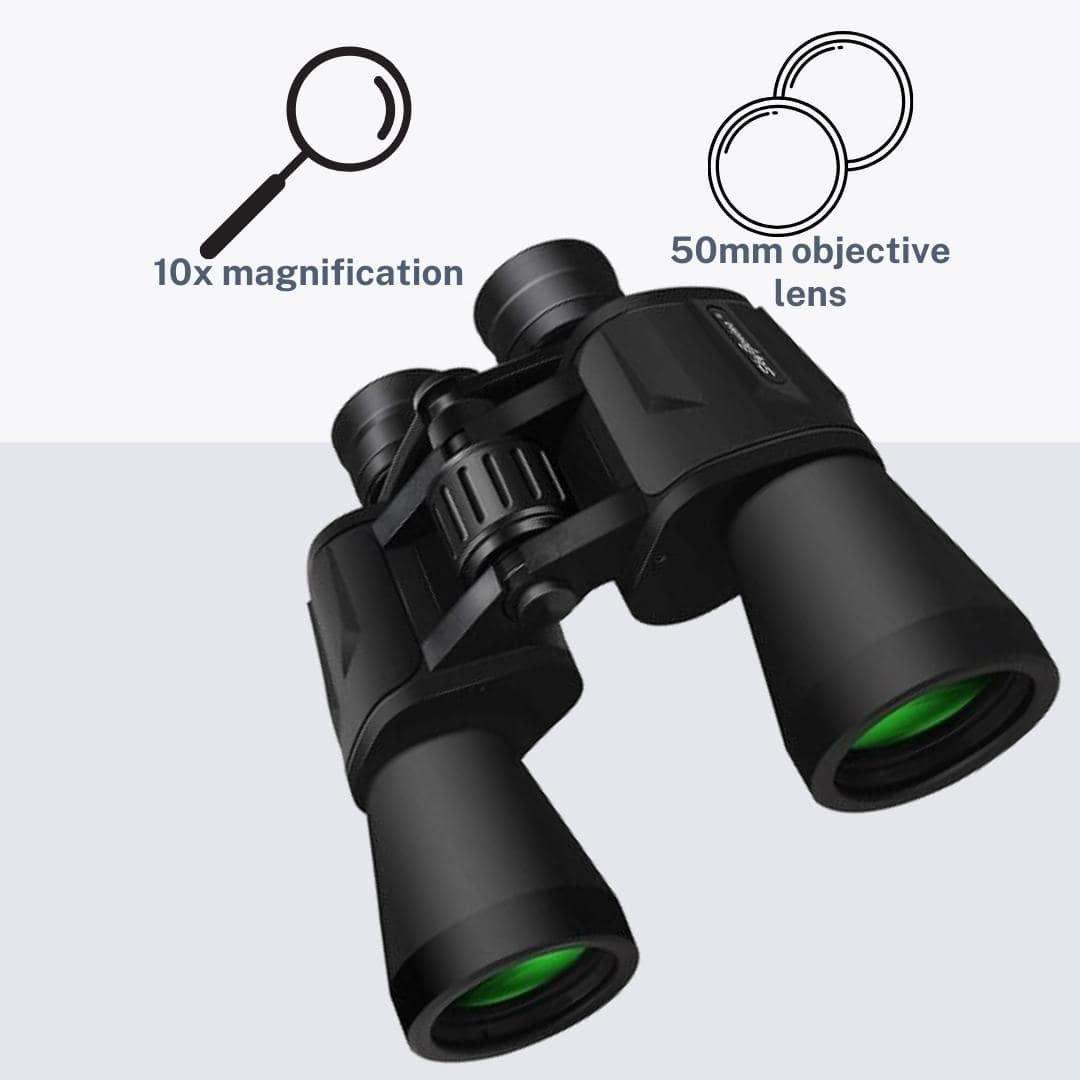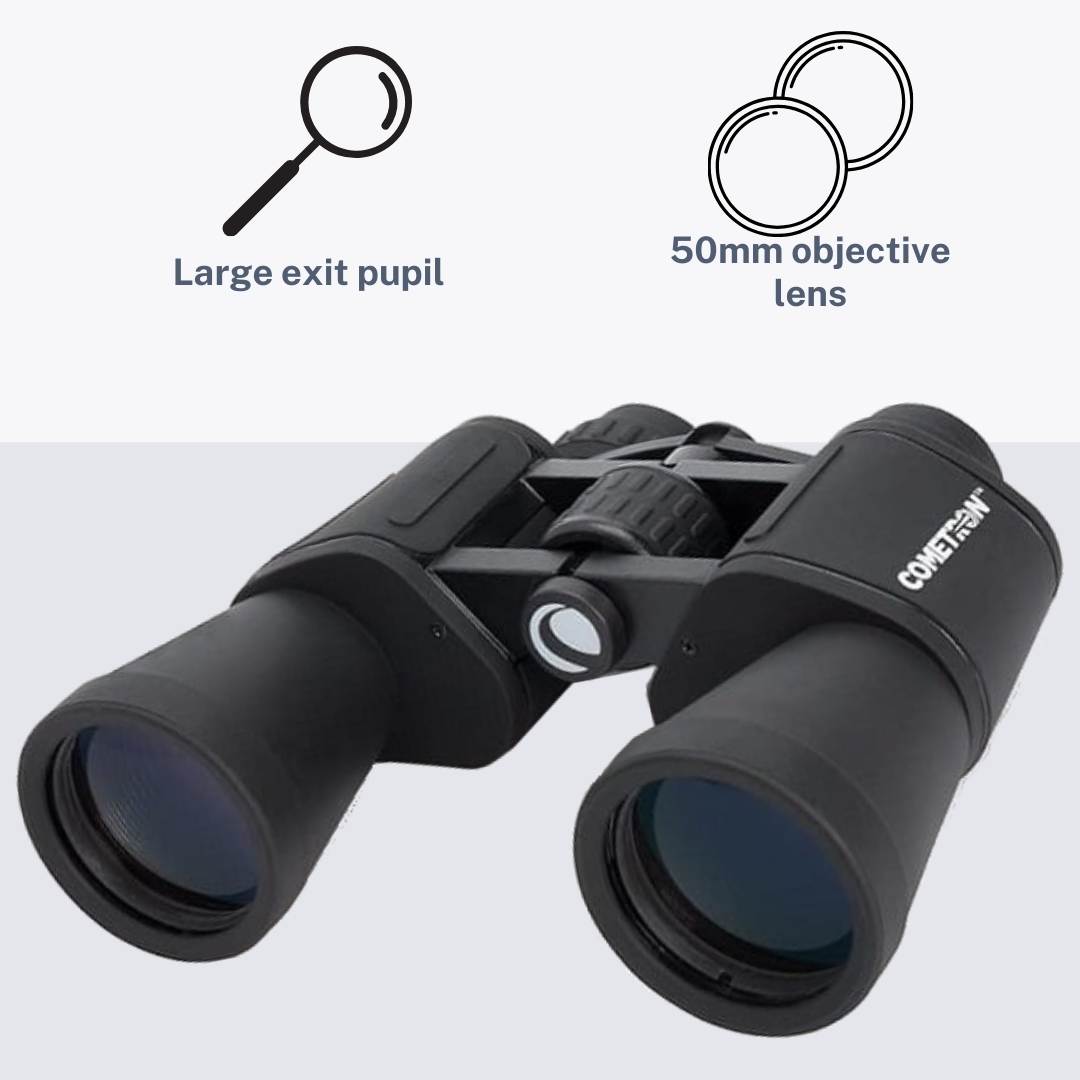If you want to start seeing celestial objects in a more detailed way, you might think that you need a telescope, but you don’t necessarily.
You can see a lot with the right pair of binoculars. Binoculars are also a user-friendly way to get into astronomy from the comfort of your backyard.
Do you need astronomy binoculars?
It’s a good idea to get astronomy binoculars that are made for astronomy because they have important features to enable you to see more when you gaze up at the night sky.
What features, you might be asking?
To answer that, let’s check out five of the best astronomy binoculars 2020: start your astronomy journey with binoculars. They have all the features you need in a pair of astronomy binoculars that will provide you with breath-taking views of celestial objects.
Best Astronomy Binoculars – Reviews & Buying guide for 2020
Best Overall Winner: Celestron SkyMaster 25X100 Astro Binoculars
These Celestron binoculars are the best binoculars for astronomy – they’re called SkyMaster and that’s no coincidence! They’re packed with features you need to be able to see and enjoy the night sky in a new, exciting way. Let’s see why they make the top spot in our reviews.
Featured specs
- 450-degree rotation
- 100mm lenses
- BaK-4 prisms
Benefits
- What makes these binoculars so effective for astronomy is that they have strong 25x magnification along with large 100mm objective lenses. They are the biggest ones that Celestron has produced in any of its products, so they’re a game changer when you want to view the planets and stars.
- These binoculars have BaK-4 prisms. This means that they provide strong light transmission so you’re always guaranteed of getting clear and bright pictures, even when visibility is poor.
- If you’re going to be using the binoculars for many hours at a time, you’ll love that it has rubber eye caps that are comfortable to wear. These also help to block out any stray light from getting in the way of your view.
- The binoculars’ eyepieces rotate 450 degrees to give you a sharper view of planets that you see.
- Thanks to how the binoculars provide you with upright views, you can make use of them for various activities, such as when you want to view snow-capped mountains or other amazing sights on earth. This makes them versatile to own.
Drawbacks
- Some people have reported that the binoculars are quite large and bulky. You won’t be able to use them without first attaching them to a stable tripod.
- Other people have mentioned that the rubber objective lens covers don’t stay in place, which can prove frustrating.
Extra Features
- These binoculars come with a protective rubber cover which not only protects it but also provides you with a firm grip when using them for greater stability.
- They’re water-resistant so you if you stumble into wet weather you won’t have to worry about damaging your binoculars. This means you can happily take your binoculars to your favorite star-gazing spots without worrying about ruining them.
- A tripod adapter is included with your purchase. This integrated photo tripod adapter makes the binoculars much more portable and offers you convenient hands-free usage.
- If you wear eyeglasses, you won’t have to worry about the eye caps getting in the way as you can fold them down.
- You get lots of great items with your purchase, such as a rain guard, lens cloth, instruction manual, carrying case, and neck strap, so you’ll have everything you need for your stargazing adventure.
Buying Advice
This is definitely one of the best astronomy binoculars on the market, offering you the chance to see much more in the sky than you ever imagined.
Runner Up: Celestron SkyMaster Giant 15×70 Binoculars
Celestron makes our list of the best astronomy binoculars again. This pair of binoculars is much cheaper while still providing you with high-quality views of the sky. Let’s check out its features!
Featured specs
- 70mm objective lens
- 15x magnification
- Waterproof exterior
Benefits
- These Celestron binoculars have a 70mm objective lens to produce more brightness so you can enjoy the view, even if you don’t have good visibility in your location.
- It comes with 15x magnification, so they’ll give you good-quality views.
- Similar to the previous Celestron binoculars, these are useful if you want to use them in dim conditions, such as at dusk. This is thanks to their multi-coated optics as well as their BaK-4 prisms that bring in more light.
Drawbacks
- The neck strap that comes included with the binoculars is said to be a bit too narrow to support the heavy binoculars.
- One of the biggest drawbacks of these binoculars is that they don’t come with a tripod included.
Extra Features
- These binoculars have a waterproof exterior.
- You can make the most of hands-free viewing by setting up the binoculars on a tripod.
- These binoculars have folded eyecups so you can fold them down if you wear eyeglasses, making them convenient for you to use.
Buying Advice
If you want a pair of astronomy binoculars that are friendlier to your budget while still delivering quality, these Celestron binoculars are worth purchasing.
Alternative: Gosky Titan 20×80 Astronomy Binoculars
One of the best things about these binoculars is that they’ve been made with versatility in mind: you can use them to gaze at the stars, view landscapes on earth, and watch wildlife. They’re the best binoculars for bird watching and astronomy!
Featured specs
- 80mm lens
- 20x magnification
- Ergonomic design
Benefits
- These binoculars have multi-coated lenses that are 80mm in diameter so you can achieve more detailed images. This also prevents the loss of light while decreasing glare so that you can see an unobstructed view.
- If you’re intending on using these binoculars regularly and for many hours at a time, you’ll want to ensure they are comfortable. These binoculars won’t disappoint because they are constructed with a rubber armor and aluminum polycarbonate framework that’s strong and ergonomic.
- To prevent your binoculars from being damaged during use, like when it’s on a tripod, your purchase includes a protective shield to block out dust as well as moisture.
Drawbacks
- One of the biggest drawbacks of these binoculars is that they require the use of a tripod. That said, this might not be a drawback because a tripod has many benefits for use with binoculars, such as that it provides more stability so that you don’t get shaky images.
- Some people have reported that the binoculars have collimation problems. Collimation refers to how the two optical tubes of the binoculars need to merge correctly. Any small misalignment can result in you finding that your view through the binoculars is not as pleasing as it should be.
Extra Features
- Besides for the protective shield, you’ll also receive a carrying case in the pack to make it easy for you to transport your astronomy binoculars.
Buying Advice
Although they’re a bit more expensive than the previous product we featured, they’re packed with lots of valuable features that make them worth purchasing. You’ll love being able to see celestial objects such as Saturn’s rings and Jupiter’s moons.
Best Budget Binoculars Astronomy Winner: SkyGenius 10×50 Powerful Binoculars
You don’t have to spend a lot of money to get a powerful pair of binoculars to view celestial objects. This one by SkyGenius is the most affordable one that comes with top-notch features. Let’s check it out in more detail.
Featured specs
- 10x magnification
- 50mm lens
- Corrective optical coating
Benefits
- These binoculars have a corrective optical coating. What this does is allow colors to be seen better and it also ensures that enough light transmission is achieved. You’ll also get improved resolution and contrast to create a sharper view.
- They have 10x magnification, which is sufficient to view celestial objects without causing shaky images to ruin the experience.
- They have what’s known as central-right adjustment. What this means is that it ensures that both eyepieces can calibrate separately, therefore providing a much clearer view.
- To make using them more comfortable, these binoculars make use of what’s known as a diopter system. This means that they will correct any imbalances in your eyes. You can make use of the focus knob easily to get the highest-quality views.
Drawbacks
- Some people who have purchased these binoculars have reported that they didn’t like the hard plastic around the eyepiece.
- Others have said that the neck strap included with the purchase is cheap and not strong enough to comfortably carry the binoculars.
- The binoculars are quite heavy, which some people have said hurts their neck when they view the stars and planets with it.
Extra Features
- The purchase of these binoculars includes a bag, strap, four lens caps, and a cleaning cloth so you’ll be able to look after your binoculars and keep them in good condition.
Buying Advice
Although they have some issues, as we’ve seen in the drawbacks section, they do redeem themselves by offering solid features you’d want in a pair of astronomy binoculars. They’re also a fantastic choice if you want the best 10×50 binoculars for astronomy without spending a lot of money.
Runner Up: Celestron Cometron 7×50 Binoculars
Another affordable pair of binoculars is this one by Celestron. It’s perfect for you if you’re a beginner. Here’s why.
Featured specs
- Aluminum construction
- Large exit pupil
- 50mm objective lenses
Benefits
- These binoculars are made from aluminum, so they’re strong and built to last.
- They have a large exit pupil. This feature provides a lot of light when it’s dark and you don’t have good visibility in your location.
- These binoculars have been made to provide you with stunning views of comets and meteors, but you can also use them for other stargazing activities and even during the day, such as if you want to view mountains or other terrestrial objects.
- These binoculars are fitted with 50mm objective lenses that collect the light well, but this also makes them light and compact, so they’re easier to hold and transport.
Drawbacks
- People have said that when compared to more high-end binoculars, these are lacking when it comes to what you’re able to see. That said, they are a budget-friendly pair of astronomy binoculars.
- Unlike other, more expensive, binoculars, these Celestron ones don’t have resistance to water or fog, so you’ll have to treat these with more TLC, such as by ensuring they stay away from moisture and dust that could damage them.
- These binoculars make use of BK-7 prism glass, not the BaK-4 glass that’s found in high-end binoculars. This means that they are prone to more imperfections and lower quality views.
Extra Features
- As with other Celestron binoculars we’ve featured in this list of reviews, these have folding eyecups that are comfortable to wear while also being easy to move out of the way. You’ll love them whether you wear spectacles or not.
- You can place the binoculars on a tripod to make use of hands-free viewing. This also makes your view much clearer because it prevents shaking.
- Your purchase includes eyepiece covers, a lens cloth, a carrying case, and objective covers. You’ll also receive an instruction manual.
Buying Advice
They’re a solid set of binoculars if you’re just starting out with your astronomy hobby. And, if you’re not sure if you want to make it your permanent hobby, you won’t feel bad about spending the money to buy these.
Astronomy Binoculars FAQ
If you’re interested in astronomy, you’ll probably have questions when it comes to how you intend to view celestial objects and what you’ll be able to see with your binoculars.
Now that you’re going to take the step of buying astronomy binoculars, here’s important information you need to know.
Can I stargaze with binoculars?
You can definitely look at the stars with a set of binoculars, so don’t think that you need to purchase a telescope in order to do so.
In fact, they are even sometimes considered to be better than telescopes. Some of the reasons for this is because they have two small telescopes that are combined and they’re easier to carry around.
What can you see with your binoculars?
You can see tons of objects in the sky with your humble pair of binoculars!
You’ll be able to view the moon, planets such as Jupiter and Saturn, and The Milky Way with your binoculars, as Sky At Night magazine reports. You’ll probably also be able to spot the Andromeda Galaxy, Hercules and Cassiopeia constellations, Messier 24 (which is the Sagittarius star cloud), amongst others.
If you’re interested in using binoculars, here are some important tips you need to follow, though, to ensure you get the best experience and value for money.
- Look for a large aperture. The aperture refers to the binoculars’ front lenses. The bigger they are, the more light they’ll be able to collect so you can see smaller objects in the sky. The front lenses, known as objectives, also need a larger aperture to help you see things in poor visibility conditions.
- Look for coated optics. These help to produce a greater quantity of contrast. Fully multi-coated is one of the best as this helps to transmit more light so that your images will have high contrast and sharpness.
- Look for water-resistance. You’ll probably want to be able to use your binoculars at your favorite stargazing locations, so it helps to choose a pair of binoculars that are waterproof so that they can’t be damaged easily from an accumulation of moisture.
- Check the weight. You don’t want to feel that the binoculars you’re using are too heavy to hold. This will make them uncomfortable during long astronomy sessions. Here’s a good tip when testing out a pair of binoculars: the center of its mass should rest comfortably in the palm of your hand. If it doesn’t, it’s probably too heavy for you. The weight of your binoculars will also affect the type of tripod you use. If your binoculars are too heavy, you’ll need an extra-strong and stable tripod to prevent your views from being blurry.
- Choose the right exit pupil. The binoculars’ exit pupil is the round disk of light that’s behind the eyepieces when you hold the binoculars in front of you. Its size is important because it has to fit inside the pupil of your eye. No one’s pupils are exactly the same size in the dark and the exit pupil size that’s right for you will change as you get older. After the age of 30, everyone loses about 1mm of exit pupil approximately every 10 to 15 years, as Sky and Telescope reports. To calculate the exit pupil of binoculars, you need to divide the aperture of the binoculars by their magnification.
What binocular size do I need for astronomy?

If you’re interested in purchasing binoculars for astronomy, you might wonder what size you need. There are a few important sizes to look for.
The first one is the magnification. Although you might be tempted to purchase a pair of binoculars that have the highest amount of magnification you can find, having binoculars with more than 10x magnification can make it more difficult for you to keep the binoculars steady, unless you have a mount.
You can achieve great images with binoculars that have magnification of about 7x or 8x.
As Sky And Telescope reports, these lower magnifications offer views that are pretty much the same as 10x. In addition to this, you might find that your eyes experience less fatigue after using low-powered lenses.
Another size to consider is the binoculars’ actual size. Although you might think that binoculars have to be as large as possible when it comes to apertures, this is a matter of preference – and tripod.
You’ll need to put your large binoculars on a stable tripod otherwise you won’t be able to hold them because they’re bulky. Bear in mind that large binoculars can also be more difficult to carry around, as we touched on in the previous question.
Pro Tip:
Sky And Telescope reports that modest-sized binoculars that are 7×40 or 10×50 are a better place to start. This is especially the case if you’re just starting out with your astronomy hobby.
In case you don’t know, “10 x 50” represents the following: the number placed before “x” refers to the power of the lens in terms of its magnification while the number that appears after the “x” refers to the diameter of the lens, so “10 x 50” means that the binoculars have a 10x magnification and a lens diameter of 50mm.
Do I need an astronomy binocular tripod?
As previously mentioned, if your binoculars are large and/or heavy, you’ll need a tripod. But a tripod can be highly useful for your binoculars regardless of their weight.
As you know, there are low-powered binoculars that are smaller in size and easier to carry around, and there are also high-powered binoculars that are bigger in size.
No matter which one you own, putting it on a stable tripod can make a huge difference in what you get to see in the sky. This is because whatever is magnified will be clearer because you’ll avoid distortions from the binoculars shaking around.
If you’re in the market for a tripod for your binoculars, you might wonder if you should choose a tripod or opt for a monopod instead. Here are some important differences between the two.
- Monopods are one-legged tripods that are usually kinder to your budget than tripods and they’re also more portable because they’re lighter in weight. These are useful to carry the weight of your binoculars so you don’t have to experience muscle strain, and they also enable you to easily pivot the binoculars to get the views you want.
- Tripods are three-legged, as you probably know. They help to stabilize the binoculars so that the images you see are clear and crisp. They are a bit heavier than monopods but this can be good because it means that they offer even more stability and are more durable.
There are some important things to look for in a tripod so that you get the best value.
- Material: What material is the tripod made out of? Wood is a good choice because it’s strong and durable, while it also absorbs vibrations really well.
- Height: Make sure the tripod you choose is comfortable to use. Here’s a good tip (via Planet Guide): the tripod should be at least six inches higher than you when fully extended so that you can use it comfortably.
- Weight: The tripod needs to be strong enough to carry the weight of the binoculars without shaking. Aim to find a tripod that’s approximately twice the weight of your binoculars.
How to track targets with a tripod?
If you own a telescope, you’ll know that its tripod can help you track the movement of celestial objects in the sky. But can you do that with your binoculars and tripod?
Yes! Here’s how.
A tripod will help to steady the images you’re seeing because it’s a hands-free option. You’ll first need to attach the binoculars to your tripod. Some binoculars have a screw thread.
You use this with an adaptor to attach them to your tripod. What if your binoculars don’t have that thread?
You’ll have to use an adaptor that’s designed in a different way.
Right, once you’ve attached your binoculars to the tripod, you can start tracking celestial objects. A good tip is to start by looking at the moon and then move on to bright stars you can see in the night sky.
It will help to have a star map with you so that you can learn what’s out there and how the stars connect to form patterns, such as in the case of Orion’s Belt. (To find out more about star maps and where to get them, read “: What Is Star Hopping And How It Can Help You Find New Stars?”).
It could be a good idea to choose a tripod that has a pan handle so that you can see more in your field of view. With smooth panning, your tripod can also work to take videos, which is a bonus if you’d like to take videos of the stars and planets.
Another thing to pay attention to when using your binoculars is if you should use a straight or angled scope.
Straight scopes do make it easier to track moving objects, but angled scopes are more comfortable because you don’t have to raise the tripod too high so they will feel more stable. Scopes will help to take your tracking efforts to a higher level.
Can you take astrophotography with binoculars?

What if you don’t want to just see the stars and planets with a set of binoculars but you want to take pictures of astronomy? Can you do this with your binoculars?
You definitely can – but you’ll need your phone so that you can take pictures of what you see. Here’s how to use your binoculars for astrophotography.
First, make sure your binoculars have the correct magnification and lens size.
When it comes to magnification, you might think you need this to be set at a very high level but higher is not always better! You need the binoculars to gather light to produce a good photograph. A good magnification is around 10x.
Then, the lens size of your binoculars is important because the larger they are, the better! They will also be influenced by your magnification. The more magnification you have, the larger your lenses need to be so that the image will be clear and bright.
Once you’re sorted with magnification and lens size, make sure you have the following items:
- A tripod: This will guarantee that your binoculars stay fixed and stable.
- A tripod adapter: If your binoculars don’t have a built-in tripod, you’ll need to buy one.
- Smartphone adapter: You need an adapter to be able to attach your smartphone to your binoculars’ eyepiece.
Once you’ve got all your items, you can set up your binoculars, tripod, and smartphone to get started with astrophotography!
It could also help you to have one more item in your astronomy arsenal: the SkyView app.
This app is useful for astrophotography because it will help you to better locate and identify stars and planets, simply by pointing your phone to the sky, whether during the night or day. It also gives you daily sky tracks so you can see where the moon and sun are located at any time.
Conclusion
Your humble binoculars might not seem adequate for astronomy, but this article now proves otherwise!
When you want to start an astronomy or astrophotography hobby, you don’t need to purchase a telescope. You can use your binoculars, but you need to make sure that they’re the right pair for the job at hand.
In this article, we’ve featured five of the best astronomy binoculars for you to choose from, based on their astronomy benefits, costs, and other features.
To help you get started with your astronomy hobby, we’ve also answered some common questions about how to use your binoculars for the best star-gazing experience.






